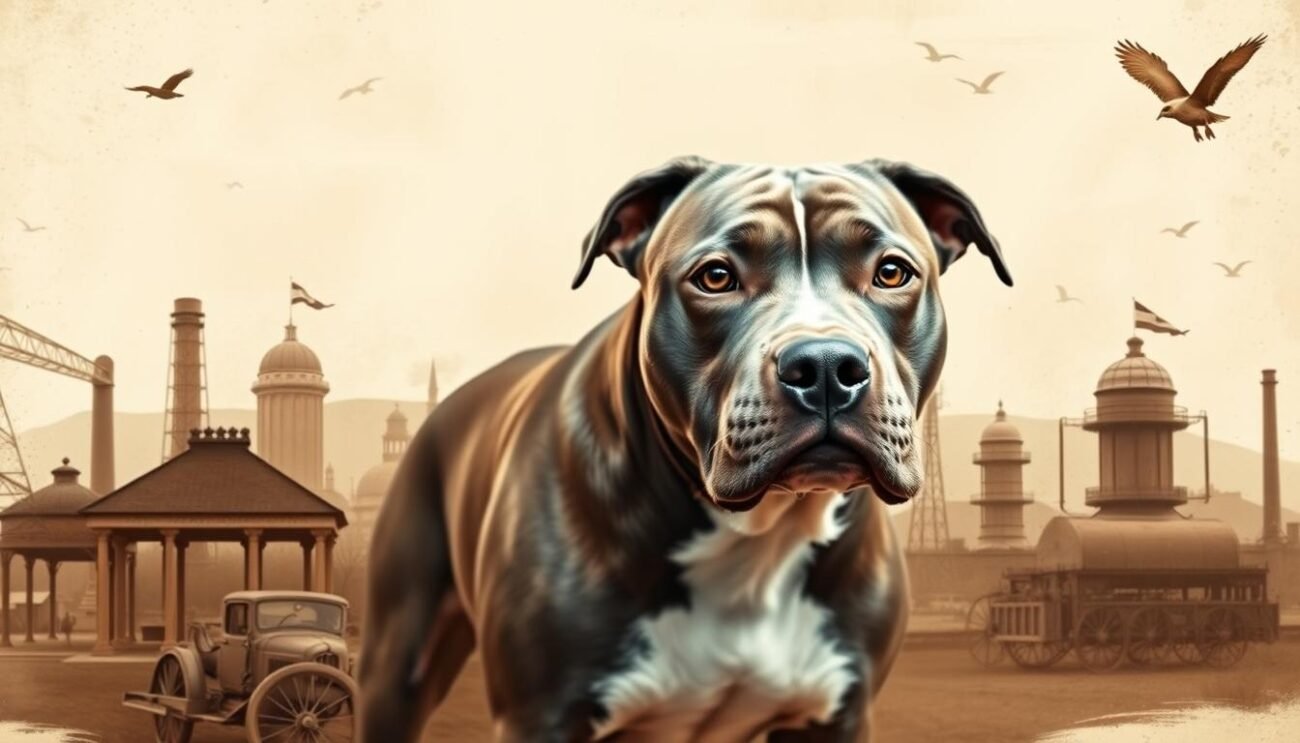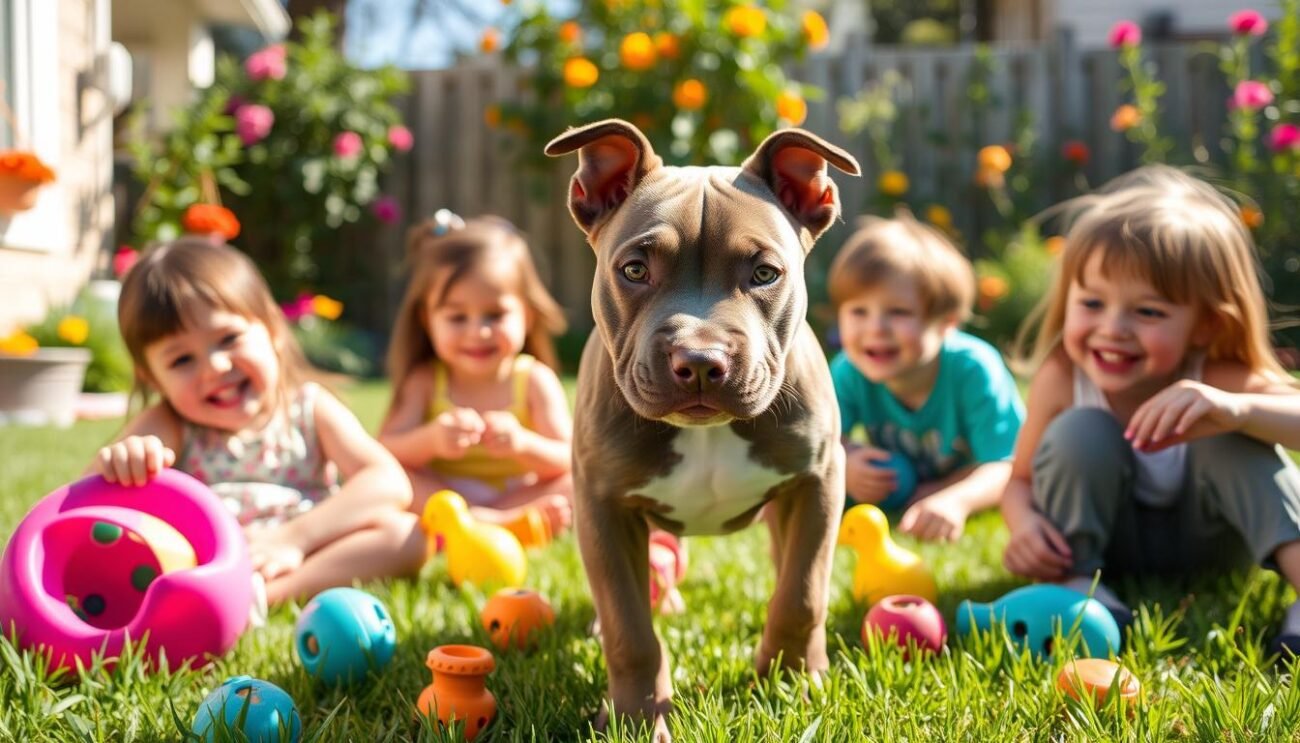The Blue Nose Pitbull puppy is a special type of American Pitbull Terrier. They are known for their bluish-gray fur and nose. This is due to a rare genetic trait.
These dogs are full of joy, love people, and are very strong. People often think Pitbulls are mean, but they are actually very loving and loyal.
Blue Nose Pitbulls are not common, but many people love them. They are smart, fun, and very loyal. With the right care and training, they make great pets.
If you’re thinking about getting a Blue Nose Pitbull puppy or just want to learn more, this guide is for you. It’s packed with information to help you understand and love these amazing dogs.

Key Takeaways
- Blue Nose Pitbulls are a rare and unique variation of the American Pitbull Terrier with distinctive bluish-gray fur and nose.
- They are known for their joyful energy, affectionate nature, and muscular, athletic build.
- Blue Nose Pitbulls can be more expensive than other Pitbull pups due to their rarity and specific genetic requirements.
- Proper training, socialization, and care are essential for the well-being of Blue Nose Pitbulls.
- These dogs are generally loving and loyal companions when provided with the right environment and guidance.
What Is a Blue Nose Pitbull?
The Blue Nose Pitbull puppy is a special type of American pitbull terrier. It’s known for its blue-gray fur and nose. This unique color comes from a genetic trait that affects the dog’s pigmentation. These dogs are loved for their friendly, loyal, and playful nature, making them great family pets.
Blue nose pitbulls are medium-sized dogs. Males are 18 to 21 inches tall and weigh 35 to 60 pounds. Females are 17 to 20 inches tall and weigh 30 to 50 pounds. They live for 12 to 15 years, sometimes longer.
These dogs can have health issues like heart disease and hip dysplasia. But, with the right care, they can live a long and healthy life. This includes regular vet visits, a good diet, exercise, and mental activities.
If you’re thinking about getting a dog, the blue nose pitbull is worth considering. They have a unique look, are very affectionate, and full of energy. Knowing what they need can make your life together happy and fulfilling.
Blue Nose Pitbull Puppy Characteristics
The blue nose pitbull is a special type of pitbull terrier. It has a unique blue-gray coat and nose. It looks different from other pitbulls because of its broad, muscular body and short snout.
Physical Appearance
The blue nose pitbull’s coat is short and shiny. It can be deep slate or light gray-blue. This special color trait gives the breed its blue nose and fur.
Size and Weight
Male blue nose pitbulls are usually 18 to 21 inches tall at the shoulder. Females are 17 to 20 inches tall. They weigh between 35 to 60 pounds, with males being slightly bigger.
Blue nose pitbulls can live up to 15 years. But, they usually live for 12 to 15 years.
Temperament and Personality
Blue Nose Pitbull puppy is loving, playful, and loyal, making them great family pets. They are very affectionate and smart, always eager to please. These dogs are full of energy and love to play.
Affectionate and Loyal
Blue nose pitbulls are very loyal and loving to their owners. They love being around people and enjoy family time. They are called “velcro dogs” because they always stick close.
Playful and Energetic
These dogs are full of energy and love to play. They enjoy being active and playing with their owners. But, they need lots of exercise and play to stay happy and healthy.

“Blue nose pitbulls are true companion dogs, eager to please and doting on their family members. Their affectionate nature and playful spirit make them a joy to have in the home.”
| Trait | Description |
|---|---|
| Affection | Blue nose pitbulls are known for their strong bonds with their owners and crave human interaction. They are often referred to as “velcro dogs” due to their tendency to follow their owners everywhere. |
| Loyalty | These dogs are incredibly loyal and devoted to their families, making them excellent companion animals. |
| Playfulness | Blue nose pitbulls are highly energetic and playful, with a zest for life that is contagious. They love to engage in physical activities and are always eager to join their owners in playtime. |
| Energy | Blue nose pitbulls have a lot of energy and require regular exercise and mental stimulation to prevent boredom and destructive behaviors. |
Blue nose pitbull puppy Training and Socialization
Raising a well-behaved blue nose pitbull puppy needs early training and socialization. These dogs are smart and eager to please. But, they can be stubborn and need consistent, positive training.
Start training and socializing your puppy as soon as you bring them home. Teach basic commands like “sit,” “stay,” and “come.” Also, expose them to different people, animals, and places to make them well-rounded.
Socialization is key for blue nose pitbull puppy. It helps them handle various situations and prevents aggression. Positive methods like clicker training work best for these smart dogs.
Some blue nose pitbulls may not get along with other dogs due to their fighting history. Working with a trainer or attending classes like Feisty Fido can help. This ensures your dog is loving and well-adjusted.

By dedicating time to training and socializing your puppy, you’ll have a happy, healthy dog. This way, your blue nose pitbull will be a positive example of the breed.
| Age Range | Training Exercises |
|---|---|
| 3-8 weeks | Name Calling, Sit, Lay Down, Listen/Watch |
| 8-12 weeks | Potty Training |
| 12-16 weeks | Leash Walking, Fetch, Jump |
“Pit bulls are known to be friendly and people-oriented pets when well-bred and properly socialized.”
Blue Nose Pitbull Health and Care
Keeping a Blue Nose Pitbull puppy healthy is crucial. They are generally well, but some genetic issues need careful watching. These dogs are medium-sized, with males weighing 35–70 pounds and females 30–60 pounds. They live about 12 to 15 years, and should weigh between 35 to 60 pounds as adults.
Common Health Issues
Blue nose pitbulls may face heart disease, hip dysplasia, thyroid issues, and allergies. Allergies can cause skin problems and itching. Hip dysplasia can lead to arthritis. Cataracts and obesity are also common. Regular vet visits and vaccinations can help manage these issues.
Grooming and Exercise
Blue nose pitbulls need balanced grooming and exercise. Their short, stiff coat needs occasional brushing and baths. They are very energetic and need lots of daily exercise. At least 45 minutes to an hour of activity is needed daily.

A balanced diet and supplements are key for their health. They do well on two meals a day, with a diet low in fat and high in protein. Supplements like glucosamine and chondroitin help with joints. Omega-3 fatty acids and vitamin E support skin and immune health. Probiotics help with digestion.
Knowing about health issues, grooming, and exercise helps your blue nose pitbull live a long, happy life. Early socialization is also vital for them to get along with other pets.
Blue nose pitbull puppy Price and Breeders
Thinking about getting a blue nose pitbull puppy? It’s key to know what affects their price and where to find good breeders. These dogs are rare because of their special color, which comes from a rare gene. This makes them pricier, usually costing between $750 and $2,000.
To get a blue nose pitbull, you need two parents with the rare gene. This makes finding them a bit harder. But, you can also look in shelters or rescue groups for a more affordable option.
| Characteristic | Blue Nose Pitbull |
|---|---|
| Weight/Height Range | 30-60 lbs, 18 to 21 inches tall |
| Lifespan | 12-15 years |
| Coat Type | Short, stiff, and glossy |
| Temperament | Affectionate, playful, and loyal |
| Intelligence | Known for high intelligence, making training easier |
| Energy Level | Highly energetic, requiring 90 minutes of exercise per day |
| Barking Habits | Not prone to excessive barking, considered quiet dogs |
| Socialization Needs | Need early socialization to be good with kids and other animals |
| Training Ease | Blue Nose Pitbulls are easier to train compared to other breeds |
| Apartment Suitability | Considered good apartment dogs, but require space for movement and exercise |
| Watchdog Abilities | Not the best watchdogs, unlikely to bark and more likely to play with intruders |
| Service Dog Potential | Blue Nose Pitbulls make excellent service dogs due to loyalty and strength |
Looking for a blue nose pitbull puppy? It’s vital to choose a reputable breeder who cares about their dogs’ health. They can help you find a healthy, well-socialized puppy. Remember, owning a dog is a big responsibility, and training is key for any breed, including the blue nose pitbull.

In summary, blue nose pitbulls are special and sought-after, but their rarity means they cost more. By finding a reputable breeder and being ready for the responsibilities of dog ownership, you can welcome a blue nose pitbull into your family.
History of the Blue Nose Pitbull
The blue nose pitbull is not a separate breed but a variation of the American pitbull terrier. This breed has a rich history that goes back to 19th-century England. It was created by mixing bulldogs and English terriers. When these dogs came to America, they were called American pitbull terriers and used for companionship and farm work.
The blue color of the blue nose pitbull comes from a rare genetic trait. This trait affects their coat and skin pigmentation. It’s caused by a recessive gene passed down through selective breeding. This gene leads to the blue nose variety within the American pitbull terrier breed.
Blue nose pitbulls have a long and complex history in the United States. They were once used for companionship, farm work, and even dog fighting, which is now illegal and frowned upon. Today, they are loved as family pets, known for their affection, loyalty, and playfulness.
Now, the blue nose pitbull is seen as a color variation of the American pitbull terrier. Its popularity is growing among dog lovers and families. With the right training, socialization, and care, they can be great additions to any home, bringing joy, love, and entertainment.

Blue Nose Pitbulls and Families
The Blue Nose Pitbull puppy is known as the “nanny dog” for being gentle with kids when socialized. They are loyal, loving, and protective, making great family pets. But, their size and strength can accidentally hurt small children, so watching them is key.
Behavior with Other Pets
Blue nose pitbulls usually don’t get along with other pets, like dogs, because of their high prey drive. They might chase and harm smaller animals, making it hard for them to live with other pets. It’s important to socialize and train them early to get along with other animals.

Blue nose pitbulls can be great family dogs, but they need careful ownership and training. With the right care, they can be loyal and loving family members.
Blue Nose Pitbull Breeders and Adoption
Finding a blue nose pitbull can be a bit of a challenge, as they are relatively rare compared to other pitbull varieties. But, dedicated blue nose pitbull breeders and reputable shelters or rescues can be great sources for those interested in adding one of these unique canines to their family.
Reputable blue nose pitbull breeders are the best option for those seeking a blue nose pitbull puppy. These breeders know a lot about the breed and can help you choose a healthy, well-socialized puppy. While a blue nose pitbull from a breeder might cost more, it’s a good investment for a positive experience and a great start for your new furry friend.
For a more affordable option, adopting a blue nose pitbull from a shelter or rescue can be rewarding. Sadly, some blue nose pitbulls end up in shelters or rescue organizations due to misconceptions about the breed. By adopting a blue nose pitbull in need, you can give them a loving home and a second chance.
| Attribute | Blue Nose Pitbull |
|---|---|
| Weight | 24-120 lb |
| Height | 14-27 inches |
| Energy Level | Moderate (3/5) |
| Exercise Needs | Moderate (3/5) |
| Playfulness | High (4/5) |
| Affection | High (4/5) |
| Friendliness to Other Dogs/Pets | Low (2/5) |
| Friendliness to Strangers | Moderate (3/5) |
| Watchfulness | High (5/5) |
| Trainability | High (4/5) |
| Grooming Needs | Low (1/5) |
| Lifespan | 10-15 years |
Whether you adopt a blue nose pitbull or get one from a reputable breeder, it’s key to understand the breed’s unique traits and needs. With the right training, socialization, and care, blue nose pitbulls can be wonderful and loyal companions. By supporting responsible breeders or adopting from shelters, you help ensure the breed’s well-being and provide a loving home for these remarkable canines.

Blue Nose Pitbull Myths and Misconceptions
The blue nose pitbull is a special type of American Pitbull Terrier. Many people think all pitbulls, including the blue nose, are mean. But, this is not true. They are actually very loving and loyal when they are trained and socialized right.
Their unique look has led to many bad stereotypes about them.
Some folks believe blue nose pitbulls are a different and better breed. But, the blue color comes from a special gene. They are still just American Pitbull Terriers. Breeders might ask for more money for “blue” puppies, saying they are rare or better.
It’s also a myth that pitbulls, like blue nose ones, have the strongest bite. Tests show most dogs bite with about 320 lbs of pressure, not the 10,000 lbs often said. Blue nose pitbulls actually have one of the lowest bite pressures.
Pitbulls, including blue nose ones, need good care and training. But, they are not naturally aggressive. They can be great family pets. With the right care, they can be loving and loyal in many homes, clearing up the myths around them.
In summary, the blue nose pitbull is a special and often misunderstood part of the American Pitbull Terrier family. By tackling the myths and misconceptions, we can help people understand these dogs better. This way, we can support their care and ownership.
Blue Nose Pitbull Activity and Exercise Needs
Blue nose pitbulls are full of energy and need lots of exercise and mental play to be happy. Experts say they should get 90 minutes to 2 hours of activity each day. This includes walks, playtime, and activities that challenge their minds and bodies.
These dogs love activities that test their athleticism, like agility courses and sports. It’s key to keep them busy to avoid boredom and bad behavior. Owners should mix up activities like training, walks, yard play, and trick learning to keep them sharp.
Remember, each blue nose pitbull is different in energy level. Tailor their exercise to their age, fitness, and training goals. This ensures they get both physical and mental challenges.
| Exercise Recommendation | Duration | Frequency |
|---|---|---|
| Walks and Runs | 90 minutes to 2 hours | Daily |
| Agility Courses | 30-60 minutes | 2-3 times per week |
| Fetch and Frisbee | 30 minutes | Daily |
| Training and Trick Practice | 15-30 minutes | Daily |
Meeting their exercise needs helps keep blue nose pitbulls healthy, happy, and well-behaved. Regular exercise and mental challenges are vital for these lively friends.
Living with a Blue Nose Pitbull
Thinking about getting a blue nose pitbull? It’s important to know their special needs and traits. They need lots of exercise, training, and socializing to be happy. These dogs are loving and loyal but might not fit in small places or homes with little kids.
Being a good owner is key when you bring a blue nose pitbull home. They need more exercise than other dogs. It’s also important to follow leash laws and understand dog body language to avoid fights.
Blue nose pitbulls can be great friends, but they’re big and strong. They live about 12 to 15 years, and some even live longer. They grow up to 18 to 21 inches tall and weigh 35 to 60 pounds. Keeping them healthy means regular vet visits, good food, exercise, and mental games.
| Characteristic | Blue Nose Pitbull |
|---|---|
| Life Expectancy | 12 to 15 years, with some living into their late teens |
| Height | Male: 18 to 21 inches, Female: 17 to 20 inches |
| Weight | 35 to 60 pounds for a healthy adult |
| Temperament | Loyal, affectionate, and intelligent |
| Health Considerations | Heart disease, hip dysplasia, thyroid problems, and allergies |
| Exercise Needs | At least 2 hours per day |
In short, owning a blue nose pitbull needs careful thought and planning. They have unique needs and traits that must be understood for a happy life. With the right care, training, and exercise, they can be loving and loyal friends.
Conclusion
The blue nose pitbull is a special type of American pitbull terrier. It has a bluish-gray coat and nose. They are known for being loving, loyal, and full of energy. But, their rare look and popularity have led to many myths about them.
It’s important to own a blue nose pitbull responsibly. This means training, socializing, exercising, and keeping them healthy. With the right care, they can be a loving part of your family.
If you’re thinking about getting a blue nose pitbull puppy, or just want to learn more, this guide is for you. It covers their traits, how they act, what they need in training, and their health. Knowing more about them can help you decide if a blue nose pitbull is right for you.
FAQ
What is a blue nose pitbull?
A blue nose pitbull is a type of American pitbull terrier. They have a bluish-gray coat and nose. They are not a different breed but a color variation within the pitbull breed.
What are the physical characteristics of a blue nose pitbull?
Blue nose pitbulls have a broad, muscular build and short snout. Their coat is short and stiff, with a glossy look. It can be deep slate to light gray-blue.
They stand 18 to 21 inches tall and weigh 30 to 60 pounds. Females are slightly smaller than males.
What is the temperament of a blue nose pitbull?
Blue nose pitbulls are loving, playful, and loyal. They make great family pets. They are smart and eager to please.
But, they need exercise and socialization. Without it, they can get bored and destructive.
How do you train and socialize a blue nose pitbull puppy?
Training and socializing a blue nose pitbull puppy is key. They are smart and eager to please. But, they can be stubborn and need consistent training.
Early socialization is also important. It helps them become well-rounded and well-behaved.
What are the common health issues for blue nose pitbulls?
Blue nose pitbulls are generally healthy but can have health issues. These include heart disease, hip dysplasia, and thyroid problems.
Regular vet visits and preventive care are vital. They also need daily exercise due to their high energy.
How much do blue nose pitbull puppies cost?
Blue nose pitbull puppies are more expensive than other pitbulls. Prices range from $750 to $2,000. This is because the blue color is rare.
Are blue nose pitbulls good with children and other pets?
Blue nose pitbulls are known as “nanny dogs” for being good with kids. But, they need supervision to avoid accidents. They also don’t get along with other pets, like dogs, due to their high prey drive.
Early socialization is key for them to get along with kids and other animals.
What are some common myths and misconceptions about blue nose pitbulls?
Many think all pitbulls, including blue nose pitbulls, are aggressive. This is a harmful stereotype. Pitbulls are loving and loyal when trained and socialized right.
Their unique look has also led to negative stereotypes about the breed.
How much exercise do blue nose pitbulls need?
Blue nose pitbulls need lots of exercise and mental stimulation. They need at least 90 minutes to 2 hours of activity daily. This includes walks, playtime, and activities that challenge them physically and mentally.
Meeting their exercise needs is important to prevent boredom and destructive behavior.






